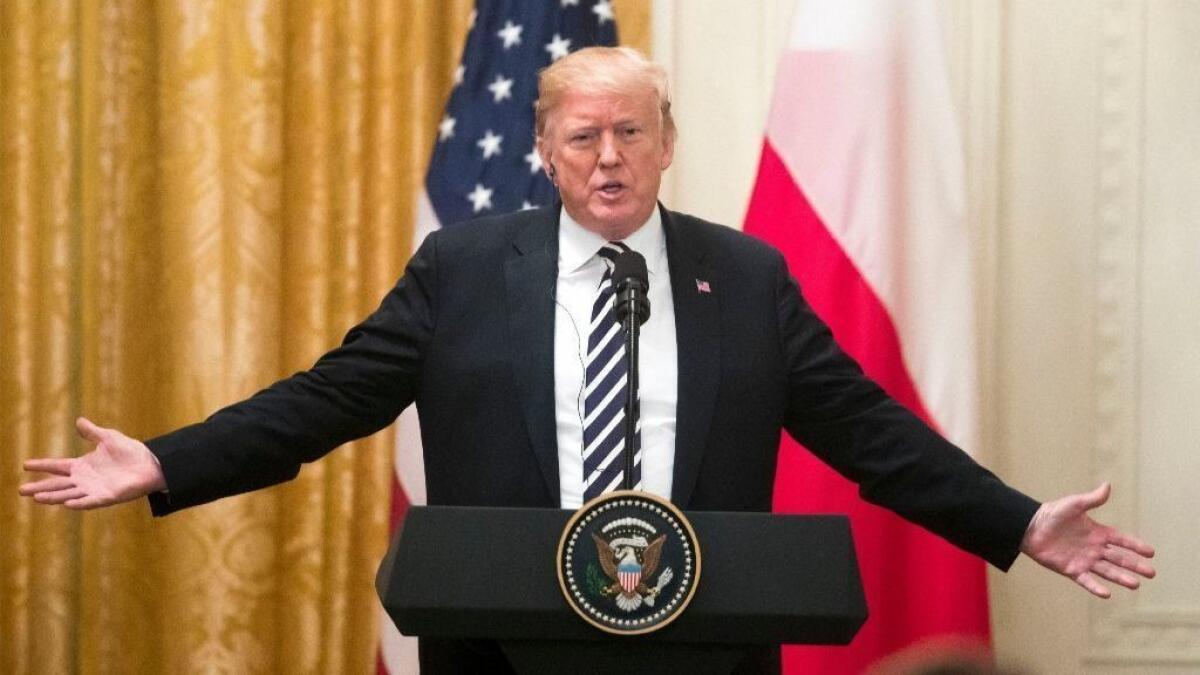Trump doesn’t talk as much about trade deficits anymore. Maybe because they’re getting worse

- Share via
Reporting from Washington — President Trump built his trade policy on an obsession with cutting fat U.S. deficits with China, Mexico, Europe and others.
But for weeks, Trump has barely mentioned that once-singular economic focus. No tweets about trade deficits since July. And the subject was conspicuously missing from his 371-word statement Monday announcing new tariffs on $200 billion worth of Chinese imports.
The reason? U.S. trade deficits have soared since he took office, driven up by strong consumer spending but also by the blizzard of tariffs he unleashed to lower deficits. Eager to avoid anticipated higher prices, American businesses have responded to tariffs by ramping up imports from China and elsewhere.
The overall U.S. trade deficit rose 10% last year to $552 billion, after being flat the prior two years. The deficit surged another 7% this year through July.
“There’s no good answer for him; that’s why he’s not talking about it,” said Derek Scissors, an economist at the conservative American Enterprise Institute, referring to the large and growing negative U.S. trade balance.
Trump addressed the rising trade deficit at a news conference Tuesday.
“I watch trade deficits because to me, deficits are very important,” Trump said. But then he added a rare note of skepticism about deficits. “They’re not everything, and they’re not exact,” he said. “Sometimes you can have … a deficit and that’s not such a bad thing.”
And at least in the short term, deficits are likely to keep growing. Stronger economic growth, boosted in part by tax cuts, has given people more money to buy imported things, and American companies will keep trying to hedge against more and higher tariffs to come.
“Everybody in their right mind is thinking about how they can get products to the U.S. and store them,” said Matt Priest, president of the Footwear Distributors and Retailers of America.
Shoes were excluded from the administration’s list of about 6,000 Chinese-made goods that beginning Monday will be subject to 10% tariffs, rising to 25% in January. But Trump has threatened to slap duties on another $267 billion worth of Chinese goods. If that happens, footwear and virtually every other product from China will be hit with tariffs because annual imports from China total about $505 billion.
China this week responded by announcing tariffs on $60 billion in U.S. imports.
Economists agree that the U.S. has long been running trade deficits chiefly due to trends involving national savings rates and investments. As such, they say it’s misguided to regard the rise and fall of trade deficits as a scorecard on economic health or trade relations with any single country, as Trump tends to do.
The U.S. trade deficit in goods with China surged to $376 billion last year and is running 9% higher through July. That’s even with exports growing as fast as imports, thanks in part to U.S. soybean farmers rushing shipments to China to avoid retaliatory tariffs from Beijing.
Trump has been railing about America’s trade deficit for decades, going back to the 1980s when Japan was America’s biggest trade problem, not China. Some economists see the U.S. deficit as a symptom of U.S. industrial weakness, but even they would take issue with the way Trump has presented the trade balance as a kind of win or loss figure, however simple that may be for people to grasp.
The debate isn’t just academic. Trump’s tariffs and other nations’ counter-tariffs could eventually shrink overall trade, but not necessarily the deficit. Past experience has shown that tariffs on imports from certain countries often result in different nations simply filling the gap, with little effect on the deficit or U.S. production and jobs
Trump’s fixation with the deficit also seems to have both confused and steered earlier negotiations with China and other parties. In a previous round of talks, Beijing thought it had a deal that would satisfy Trump’s desire to cut the deficit as it offered to buy a lot more U.S. soybeans, liquid gas and other American products, only to have Trump later nix it.
With Trump more recently having toned down his fiery rhetoric about massive deficits, it may have become easier for administration officials to convey a clearer message to Beijing about what the U.S. is seeking from China: real reforms that would address systemic problems involving protection of intellectual property, market access for American firms and other state-controlled mercantilist policies, in compliance with Beijing’s World Trade Organization commitments.
Craig Allen, president of the U.S.-China Business Council, said there has been an evolution of thinking on China from the Trump administration. But now, he said, “I have no doubt that the Chinese side is clear about what the U.S. expectations are.” The challenge, he added, is whether the two sides will sit down and translate the American demands to concrete actions.
Despite the new tariffs and threats of more to come, Trump seemed to offer some optimism that a deal could be cut. “We’re making a lot of headway with China,” he said. “China wants to come over and talk, and we are always open to talking.”
Andy Rothman, an investment strategist at Matthews Asia in San Francisco, thinks the Chinese still don’t know for sure what Trump wants.
Whether Trump is still focused on the deficit or on other systemic issues may not make that much difference in the end, said Rothman, who was a former economic officer at the U.S. Embassy in Beijing.
“When I look at the deals [Trump’s] made with Mexico, South Korea and the EU, things that have been previously described as core issues, whether deficits or not, were not addressed,” he said. “It really comes down to: Does President Trump want to make a deal?”
Follow me at @dleelatimes
More to Read
Inside the business of entertainment
The Wide Shot brings you news, analysis and insights on everything from streaming wars to production — and what it all means for the future.
You may occasionally receive promotional content from the Los Angeles Times.











